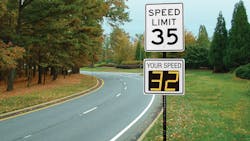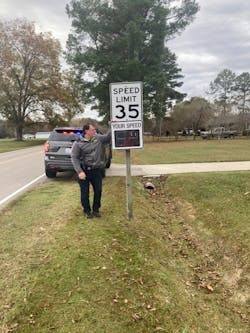Radar Speed Signs: A Small Solution to a Big Problem
When agencies in small towns attack problems, creativity is a must. Gates County, North Carolina Sheriff Ray Campbell was tasked with addressing the issue of drivers coming into the town of Gatesville.
“They have complained for years about speeders coming through,” he says. “It drops down from 55 mph to 35 mph to 20 mph on Main Street. On another entrance into the county, it drops from 55 mph to 45 mph.”
This article appeared in the January/February issue of OFFICER Magazine. Click Here to view the digital edition. Click Here to subscribe to OFFICER Magazine.
As the leader of a small agency, he says resources are sparse. “The townspeople had asked for us to put units out there with radar to try to slow people down. I just didn’t have the manpower. There are only 15 of us; we only have two deputies per shift and not everybody is radar certified.”
The Gates County Sheriff’s Office purchased the Radarsign TC-400 through the use of a grant. “It is worth every penny, and I’d buy another one tomorrow if that one got messed up,” says Campbell. He mounted it to a 45 mph signpost running parallel to the highway. “It is the ticket,” he says with a laugh. “It may be a bad choice of words there, but I’m telling you, that thing does flat work. The first time we put it up, I went out the next morning and just sat and watched people hit the brakes, watching that thing go off."The Radarsign TC-400 is compact and weighs about 40 lbs. The unit is available in battery or AC-powered models and the display is easily readable from up to 400 feet away.
One of the biggest thing the sign has helped with has been the data from the device. “We can run 15 to 20 different graphs from the data we collect off of this thing,” he says. “The time, the data and the speed. The first time we put it up, I got back about 12 to 15 pages of data.” The Gates County Sheriff’s Office turned data from the sign into the state traffic engineer who Campbell said he is working with to drop the speed limit on the road to 35 mph. “He’s got enough data and enough proof and I’ve got enough leverage to make it happen because I’ve got page after page of vehicles coming through there, through a 45 mph at mid-70s.”
The agency moves the sign around the county though the use of brackets. He says that it only takes his deputies minutes to put the sign up and take it down. “It’s just a matter of changing out the batteries and putting it up.”
Before purchasing the easily portable unit, Campbell says that the agency borrowed a trailered radar sign from a neighboring agency. “You had to pull it on a trailer and set the thing up beside the road,” he says. “The set up on that is so much more. Then you have to chain the whole trailer and everything down and get it off the road. Being able to have the ability to mount that thing on a signpost or a utility pole is fantastic. It’s a whole lot less trouble and a whole lot cheaper than a pull behind mobile radar unit.”
Campbell says that he’d recommend the device to other agencies similar to his. “I’d tell any agency, or sheriff’s office, that if you’ve got a small town and you’ve got a problem with speeders coming through and you don’t have the ability to set a unit out there with radar and write tickets all day long, this thing works. The selling point for the sign is it’s so easy to set up. You run it off your phone, you change the times and it’s very easy to move from place to place. One deputy can carry it out, set it on the sign and be done with it in three or four minutes.”
This article appeared in the January/February issue of OFFICER Magazine.

Paul Peluso | Editor
Paul Peluso is the Managing Editor of OFFICER Magazine and has been with the Officer Media Group since 2006. He began as an Associate Editor, writing and editing content for Officer.com. Previously, Paul worked as a reporter for several newspapers in the suburbs of Baltimore, MD.




